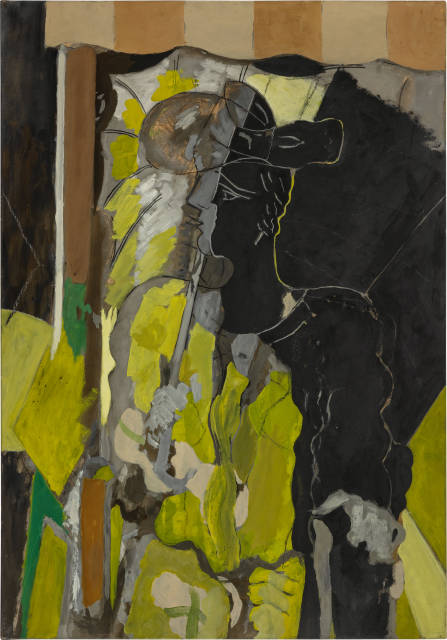- FR
S’inscrire
- Ventes Classiques
- Online Only
- Ventes passées
- Acheter
- Vendre
- Plus
- Galerie
- Commerce d'art
- Maison d'Édition
- Kornfeld aujourd’hui
- L'histoire de la Maison
- Informations



Argenteuil 1882 - 1963 Paris
1943
Gouache and pastel on paper, mounted on canvas
92 x 65 cm
Number "109" twice on the back of the chassis
Certificate of authenticity on photograph, signed by Claude Laurens, Paris, dated 24 June 1974, and by Daniel-Henry Kahnweiler, Paris, dated 6 July 1974, is available in copy
Galerie Louise Leiris, Paris, labelled and numbered "015456"/"1594" on the reverse, acquired there by
Saidenberg Gallery, New York, from there to
Private collection USA, by inheritance to
Private collection USA
Tel Aviv 1971, Musée de Tel Aviv, Expositions Inaugurales, Maîtres Français du XXe Siècle, cat. no. 12, labelled on the reverse
In overall impeccable condition and fresh in colour
After Fauvist beginnings, Georges Braque, together with Pablo Picasso, became one of the founders and main representatives of early analytical Cubism. The caesura of the First World War also led Braque to yearn for and return to a classical ideal ("retour à l'ordre") and thus to turn away from his strict Cubist style.
Braque was drafted into the 224th Infantry Regiment and promoted to first lieutenant. A shell splinter injured his head so badly in 1915 that he was discharged from service after a skull operation and a long convalescence. Back in Paris in 1917, he began a new way of painting, which he explained in December in the magazine "Nord-Sud" under the title "Pensées et réflexions sur la peinture" ("Thoughts and Reflections on Painting"). His painting style changed radically, the composition became freer, the application of colour drier. In addition to the recurring still lifes, Braque painted his pioneering figurative motifs, in which figure, space and interior literally interpenetrate. These paintings are profoundly subtle, finely nuanced and luminously crystalline.
He was repeatedly drawn to Normandy, where, in 1930, he finally set up a holiday home with a studio in Varengeville-sur-Mer near Dieppe. The Second World War led to another caesura in his oeuvre: the colours became more restrained and black became a defining basic tone in his painting. The artist spent the war years in seclusion in Paris. The painting "Woman with Parasol" offered here was probably created there. The woman sitting in the beach chair could be his wife Marcelle Lapré Braque. The front of the elegant lady is gently illuminated by the sun's rays, while the back literally dissolves into the black shadow. It is an impressive reminiscence of the happy days in Normandy, set against the background of the turmoil of war in Paris.
1943
Gouache und Pastell auf Papier, auf Leinwand aufgezogen
92 x 65 cm
Rückseitig auf dem Chassis zweimal mit der Nummer "109"
Echtheitszertifikat auf Fotografie, darauf signiert von Claude Laurens, Paris, datiert vom 24. Juni 1974, und von Daniel-Henry Kahnweiler, Paris, datiert 6. Juli 1974, liegt vor
Galerie Louise Leiris, Paris, rückseitig mit Etikett und den Nummern "015456"/"1594", dort erworben von
Saidenberg Gallery, New York, von dort an
Privatsammlung USA, durch Erbschaft an
Privatsammlung USA
Tel Aviv 1971, Musée de Tel Aviv, Expositions Inaugurales, Maîtres Français du XXe Siècle,
Farbfrisch und in tadelloser Gesamterhaltung
Nach fauvistischen Anfängen wurde Georges Braque zusammen mit Pablo Picasso einer der Begründer und Hauptvertreter des frühen, "analytischen Kubismus". Die Zäsur des Ersten Weltkriegs führte auch bei Braque zu einer Sehnsucht und Rückbesinnung auf ein klassisches Ideal ("Retour à l’ordre") und somit zu einer Abwendung von seinem strengen kubistischen Stil.
Braque wurde zum 224. Infanterieregiment eingezogen und zum Oberleutnant befördert. Ein Granatsplitter verletzte ihn 1915 so sehr am Kopf, dass er nach einer Schädeloperation und einer langen Rekonvaleszenz aus dem Dienst entlassen wurde. Ab 1917 wieder zurück in Paris, begann er eine neue Art der Malerei, die er im Dezember in der Zeitschrift "Nord-Sud" unter dem Titel "Pensées et réflexions sur la peinture" (Gedanken und Überlegungen zur Malerei) erläuterte. Sein Malstil änderte sich radikal, der Bildaufbau wurde freier, der Farbauftrag trockener. Neben den immer wieder vorkommenden Stillleben malte Braque seine bahnbrechenden figurativen Motive, bei denen sich Figur, Raum und Interieur förmlich durchdringen. Diese Gemälde sind zutiefst subtil, fein nuanciert und leuchtend-kristallin gemalt.
Immer wieder zog es ihn in die Normandie, wo er sich schliesslich 1930 in Varengeville-sur-Mer neben Dieppe ein Ferienhaus mit Atelier einrichtete. Der Zweite Weltkrieg führte erneut zu einer Zäsur in seinem Œuvre: Die Farben wurden verhaltener, Schwarz wurde zu einem bestimmenden Grundton seiner Malerei. Die Kriegsjahre verbrachte der Künstler zurückgezogen in Paris. Dort dürfte auch das hier angebotene Bild der "Frau mit Sonnenschirm" entstanden sein. Bei der im Strandkorb sitzenden Frau könnte es sich um seine Ehefrau Marcelle Lapré Braque handeln. Die Vorderseite der eleganten Dame wird sanft von den Sonnenstrahlen beschienen, während sich der hintere Teil im schwarzen Schatten förmlich auflöst. Es ist eine eindrückliche Reminiszenz an die glücklichen Tage in der Normandie im Spiegel der Kriegswirren in Paris.
| Suisse | CHF | Offre individuelle |
| Europe | CHF | Offre individuelle |
| Outre-mer | CHF | Offre individuelle |




